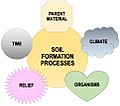Pedogenesis facts for kids
Have you ever wondered how the ground beneath your feet was made? It's not just dirt! The process of soil forming is called pedogenesis or soil formation. It's a slow but amazing journey that takes thousands of years.
Many things help soil form, but one of the biggest is climate. Places with more rain and warmer temperatures usually have more developed soils. This is because warmth speeds up how rocks break down, a process called weathering. For example, if the temperature goes up by 10 degrees Celsius (20 °F), rocks can break down 2 to 3 times faster!
Climate also decides which plants and animals can live in an area. These living things play a huge role in shaping the soil, both by adding chemicals and by moving things around with their roots or by burrowing.
Contents
How Living Things Help Soil Form
Plants and animals are super important for making different kinds of soil. The types of living things in an area create unique soil types.
- In conifer forests (like those with pine trees), the fallen needles make the soil a bit acidic.
- In mixed or deciduous forests (where trees lose their leaves in autumn), a thick layer of humus forms. Humus is decayed plant and animal matter.
- Prairies, which are large grasslands, have a lot of humus building up. This creates very dark, thick soil that is often great for growing crops.
What is Parent Material?
The original rock that soil forms from is called 'parent material'. Think of it as the "parent" of the soil! This parent material is often the bedrock found deep underground.
Soil can form from different kinds of parent material, including:
- Eolian material: This is rock or sand carried by the wind.
- Glacial material: This comes from glaciers that have moved and ground down rocks.
- Alluvium: This is soil or sand left behind by flowing water, like rivers.
- Lake material: This is sediment that settles at the bottom of lakes.
What is Pedology?
Pedogenesis is a major topic in the science of pedology. Pedology is the study of soil in its natural environment.
Scientists who study pedology also look at:
- Soil morphology: This is what the soil looks like, including its layers and features.
- Soil classification: This is how soils are grouped and named, like a taxonomy for soils.
- Soil distribution: This means where different types of soil are found around the world.
Related pages
Images for kids
-
Soil, on an agricultural field in Germany, which has formed on loess parent material.
See also
 In Spanish: Pedogénesis para niños
In Spanish: Pedogénesis para niños



